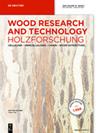Antifungal properties of lauric arginate (LAE) treated wood
IF 1.6
3区 农林科学
Q2 FORESTRY
引用次数: 0
Abstract
Abstract This study investigated the efficacy of lauric arginate (LAE) as a potential preservative against wood deteriorating fungi. First, the antifungal properties of LAE against two brown rot fungi, Gloeophyllum trabeum (G.t.) and Rhodonia placenta (R.p.), and two white rot fungi, Trametes versicolor (T.v.) and Irpex lacteus (I.l.) were examined using malt-agar media as substrate. Then the biological resistance of LAE-treated wood specimens (10, 20, and 25 % LAE solutions) was tested following American Wood Protection Association (AWPA) E10 soil-block test procedures. The in vitro study showed LAE actively inhibited the growth of all the fungi tested compared to growth in control plates but there were no considerable changes observed in the morphology of fungi hyphae. Wood impregnated with LAE showed increased weight percent gain as a function of treatment concentration. Characterization of LAE-treated wood on a thermogravimetric analyzer showed LAE shifted the thermal degradation temperatures to lower stages but did not significantly improve the thermal stability of the treated specimen. LAE in wood significantly suppressed fungus growth, leading to decreased mass loss but it also leached out from wood specimens during fungi exposure.月桂酸酯(LAE)处理木材的抗真菌性能
摘要本研究探讨了月桂精氨酸(LAE)作为木材变质真菌的潜在防腐剂的防腐效果。首先,以麦芽-琼脂培养基为底物,研究了LAE对两种褐腐真菌Gloeophyllum trabeum (g.t.)和Rhodonia胎盘(r.p.)以及两种白腐真菌Trametes versicolor (t.v.)和Irpex lacteus (i.l.)的抑菌性能。然后按照美国木材保护协会(AWPA) E10土块试验程序测试LAE处理的木材样品(10、20和25 % LAE溶液)的生物抗性。体外研究表明,与对照板相比,LAE对所有真菌的生长都有抑制作用,但真菌菌丝形态没有明显变化。LAE浸渍木材的增重率随处理浓度的增加而增加。用热重分析仪对LAE处理过的木材进行表征,结果表明LAE将热降解温度转移到较低的阶段,但并没有显著改善处理过的木材的热稳定性。木材中的LAE显著抑制真菌生长,导致质量损失减少,但在真菌暴露过程中也会从木材样品中浸出。
本文章由计算机程序翻译,如有差异,请以英文原文为准。
求助全文
约1分钟内获得全文
求助全文
来源期刊

Holzforschung
工程技术-材料科学:纸与木材
CiteScore
4.60
自引率
4.20%
发文量
83
审稿时长
3.3 months
期刊介绍:
Holzforschung is an international scholarly journal that publishes cutting-edge research on the biology, chemistry, physics and technology of wood and wood components. High quality papers about biotechnology and tree genetics are also welcome. Rated year after year as one of the top scientific journals in the category of Pulp and Paper (ISI Journal Citation Index), Holzforschung represents innovative, high quality basic and applied research. The German title reflects the journal''s origins in a long scientific tradition, but all articles are published in English to stimulate and promote cooperation between experts all over the world. Ahead-of-print publishing ensures fastest possible knowledge transfer.
 求助内容:
求助内容: 应助结果提醒方式:
应助结果提醒方式:


